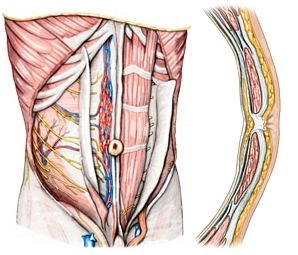1. Muscles of the anterior abdominal wall
Rectus abdominis:Straight abdominal muscle invested by the rectus sheath with its three to four tendinous intersections (intersectiones tendineae) conjoined with the anterior lamina of the rectus sheath
pyramidalis:Originates at the superior pubic ramus, inserts in the linea alba, is situated anterior to the rectus abdominis and invested by its own sheath in the anterior lamina of the rectus sheath
2. Layered anatomy of the anterior abdominal wall
Rectus sheath: Invests the rectus abdominis; from the umbilicus to halfway between umbilicus and symphysis it demonstrates an anterior and posterior lamina; the posterior lamina terminates here as the arcuate line, above which the external oblique conjoins with the anterior lamina of the rectus sheath, while the internal oblique fuses with both the anterior and posterior lamina the transversus abdominis does so just with the posterior lamina.
Linea semilunaris: Transition zone between the aponeurosis of the lateral abdominal muscles and the lateral margin of the rectus sheath.
Linea alba: About 1cm wide taut strip of connective tissue between the left and right rectus sheath, extending from the sternum to the pubic symphysis.
Transversalis fascia: Craniad to the arcuate line it invests the posterior lamina of the rectus sheath, while caudad to the line it directly covers the rectus abdominis.
3. Interior aspect of the abdominal wall
Median umbilical fold: Median peritoneal fold running from th umbilicus to the bladder and containing the median umbilical ligament (connective tissue strand = remnant of the embryonic urachus).
Medial umbilical fold: Paired peritoneal fold containing the paired medial umbilical ligaments = obliterated remnants of the paired umbilical arteries.
Lateral umbilical fold: Paired peritoneal fold investing the paired inferior epigastric arteries with its two accompanying veins each.
4. Blood supply and innervation
a) Arteries
Superior epigastric artery: Extension of the internal thoracic artery, anastomoses with the inferior epigastric artery at the level of the umbilicus.
Inferior epigastric artery: Originates at the external iliac artery and like its internal counterpart courses on the posterior aspect of the rectus abdominis in the rectus sheath.
Superficial epigastric artery: Originates at the femoral artery and after crossing the inguinal ligament it fans out in the subcutaneous tissue of the anterior abdominal wall.
Posterior intercostal arteries VI – XI and subcostal artery: They originate at the thoracic aorta; their terminal segments course obliquely caudad between the internal oblique and transversus abdominis, and reaching the rectus sheath from lateral they anastomose there with the superior and inferior epigastric arteries.
b) Veins
Superior epigastric veins: They accompany the corresponding artery, anastomose with branches of the inferior epigastric artery and drain into the internal thoracic veins.
Inferior epigastric vein: Fans out into veins accompanying the inferior epigastric artery and drains into the external iliac vein.
Superficial epigastric vein: Parallels the corresponding artery (see above).
c) Lymph vessels
Superficial lymph vessels: Craniad to the umbilicus they course to the axillary lymph nodes (Nodi lymphatici axillaris) and caudad to the inguinal lymph nodes (Nodi lymphatici inguinales).
Deep lymph vessels: Usually they parallel the blood vessels and terminate in the parasternal, lumbar and external iliac lymph nodes.
d) Nerves
Intercostal nerves VI – XII: As anterior rami of the thoracic nerves VI – XII they course posterior to the coastal cartilages caudad into the abdominal wall between the internal oblique and transversus abdominis; motor branches supply the anterior and lateral abdominal muscles and sensory branches the skin of the abdominal wall.
Iliohypogastric, ilioinguinal and genitofemoral nerves:Are part of the motor and sensory innervation of the inferior abdominal region and the genitals.
